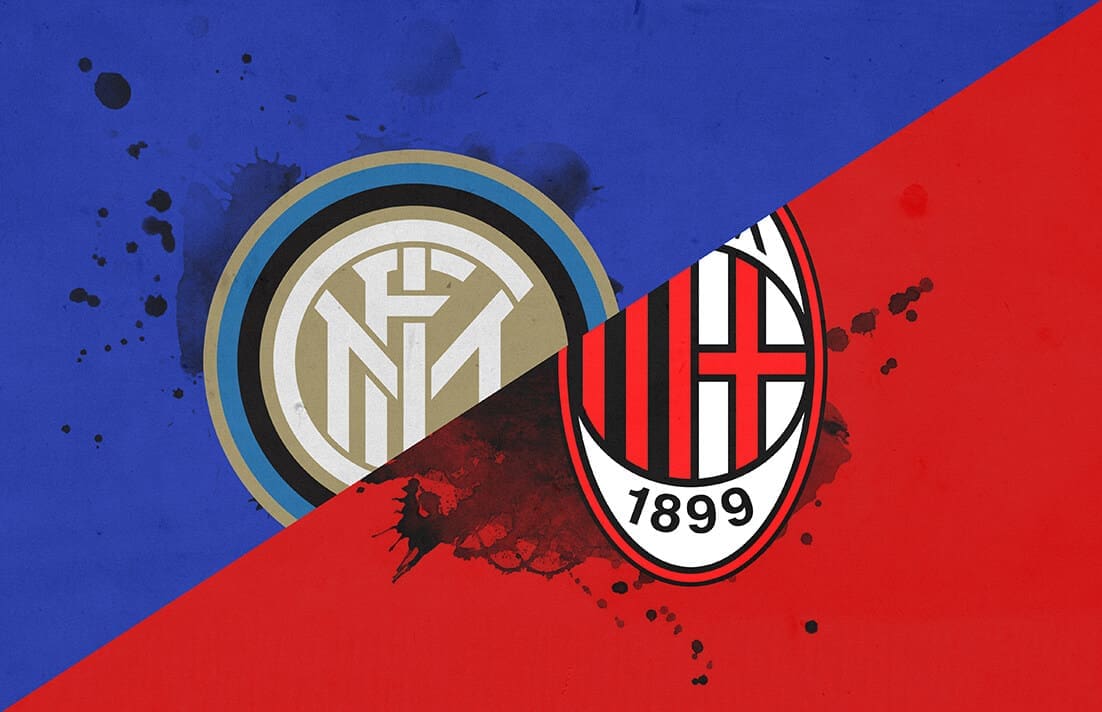This post initially featured on our dedicated Serie A analysis site, serieaanalysis.com
The Derby della Madonnina is always a special game, and albeit the decline of the Milan clubs in recent years might have affected the spectacle, the emotions of such a historically rich match have remained untouched. Although both Milan and Inter had quite a slow start to the season, their recent games have shown some improvements, and the Derby represented the chance to prove their worth against a tough opponent. Spalletti fielded an eleven which could have resembled a 4-2-3-1 at first, but as the game started, the players’ positioning clearly formed a 4-3-3 with the centre-midfielders high in the half-spaces. Gattuso, instead, stuck to his usual formation and men, in Milan’s 4-3-3 that would transition into a 4-5-1 out of possession.
Inter (4-3-3): Handanović; Vrsaljko, De Vrij, Skriniar, Asamoah; Vecino, Brozović, Nainggolan; Politano, Icardi, Perisic.
Milan (4-3-3): Donnarumma; Calabria, Musacchio, Romagnoli, Rodriguez; Kessié, Biglia, Bonaventura; Suso, Higuaìn, Calhanoglu.
Inter’s man-oriented press
This season, fans have become accustomed to Milan building up more patiently compared to last season, looking to attract the opposition deep to penetrate and access the centre-midfielders or wingers dropping in the half-space between the lines, through wide triangles or individual dismarking movements on the 2nd line. For example, against Roma, Milan accessed the half-spaces by spreading the centre-midfielders and attracting one of De Rossi and N’Zonzi wide, stretching Roma’s midfield line horizontally.
Thus, to prevent Milan from building up and gaining access to the space between the lines, Inter pressed man-oriented in a 4-4-2 shape, as Nainggolan joined Icardi on the first line to press the centre-backs in a 2v2. By pressing in said structure, Inter had natural access to each of Milan’s men. On the 2nd line, when Gattuso’s side built up on one side Nainggolan dropped back to mark Biglia, the ball-side winger pressed the full-back and the double pivot marked the ball-near centre-midfielders whilst the ball-far winger tucked inside to mark the ball-far centre-back.

Inter’s man-oriented pressing. Nainggolan marks Biglia, Asamoah steps out on Suso, Icardi and Perisic respectively press Musacchio and Calabria, and Politano tucks inside to mark Romagnoli.
On the last line, the full-backs marked the wingers, following them inside and deep, and the centre-backs defended against Higuaín in a 2v1. On the other hand, when Milan were on the ball in deep central areas, Nainggolan stayed on the first line, the double pivot pressed the ball-side centre-midfielder and pivot, and the ball-far winger controlled the ball-far centre-midfielder, ready to step out on the full-back after a switch.
Due to Milan’s ceaseless will to build up from the back, Inter were able to stop them from progressing quite easily, forcing the Rossoneri to play long balls (due to the lack of passing options) without having a specific receiver in mind or plan to attack the second ball.
Inter’s CMs occupy the half-spaces
Milan defends in a 4-5-1 mid-block out of possession in which the ball-side centre-midfielder joins the first line to close down whoever’s ahead of him (usually the centre-back), creating a situational 4-4-2; this approach is supposed to prevent the opposition from penetrating centrally.
However, due to poor compactness on the 2nd line, caused by Biglia’s inability to control the space aside him and poor pressing angles from the midfielders stepping out, opposition teams have been able to access the space beside the pivot. To do so, Spalletti decided to field two midfielders, Nainggolan (Borja Valero once he came on for the injured Belgian) and Vecino, in their respective half-space in a 4-3-3 to exploit the aforementioned structural issue.
Therefore, the central defenders (vertically) or full-backs (through diagonal passes) had direct access to the half-spaces after having circulated patiently across the back four to invite one of the centre-midfielders out of position.
 Nainggolan and Vecino positioned in their respective half-spaces. Bonaventura steps out on Brozovic, who’s able to access Vecino high in the right half-space.
Nainggolan and Vecino positioned in their respective half-spaces. Bonaventura steps out on Brozovic, who’s able to access Vecino high in the right half-space.
These situations turned out to be the most effective pattern to progress up the field and Inter were able to create a couple of chances through their midfielder’s positioning. Still, when Inter created positional superiority and bypassed the opposition’s midfield, once they got to the final third, they lacked ideas and were too reliant on crosses (only 10 out 44 of Inter’s crosses were completed), which wasn’t helped by a generally poor occupation of the box.
Moreover, due to the rather conservative staggering in possession with deep full-backs who were reluctant push-up, Inter were quite predictable and unable to exploit Milan’s structural issues as much as they could have had the full-backs attacked the space behind the opposition wingers.
This way, the full-backs either could have created 2v1s against Milan’s full-backs or acted as pins to force the wingers to track back, allowing their side to disorganise Gattuso’s side’s block and access the half-spaces more frequently due to the reduced presence in the centre.
Conclusion
Icardi’s extraordinary double movement to manipulate Musacchio and head the ball home in the 91st minute was the winner that rewarded the better side throughout the game, despite having faced some difficulties in possession due to lack of movement and a conservative occupation of the field. Spalletti’s side’s pressing was very effective and prevented Milan from creating pretty much any chance, or even progressing up the field with continuity. And whilst Milan’s positional defending was generally quite compact, even though the Nerazzurri successfully exploited the Rossoneri’s structural issues in a couple of situations, this was facilitated by Inter’s poor possession phase.
Thus, on the one hand, Spalletti will be happy to have won the derby and climbed up to third place, on the other hand, he shouldn’t be happy of his team’s possession spells.
As to Milan, Gattuso will have to find solutions on how not to isolate Higuain up front and be so vulnerable to aggressive pressing, as well as providing his team with some instructions or patterns in order not to be as predictable in the final third as Milan has been so far, relying on the individual spark which, especially against better teams, won’t always arrive.






Comments